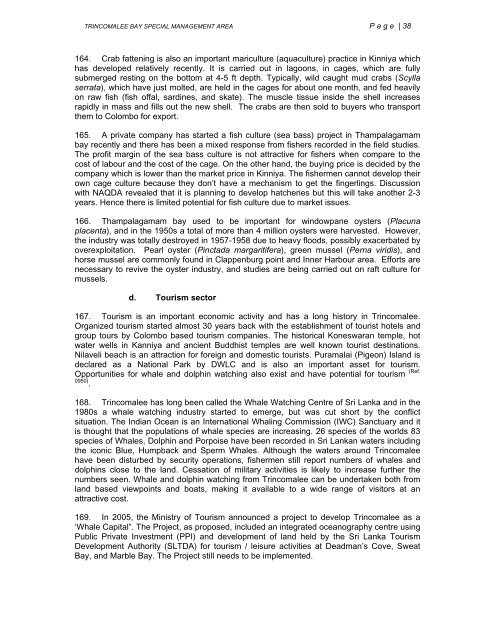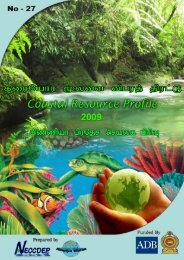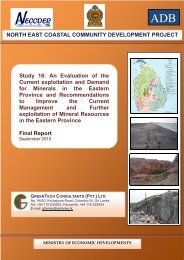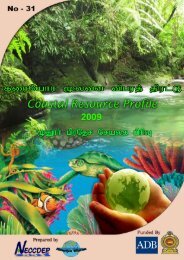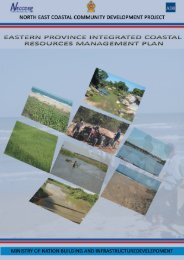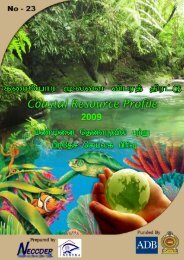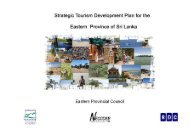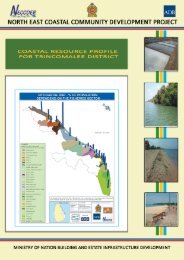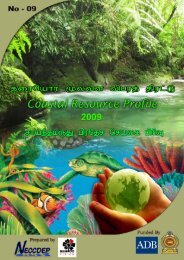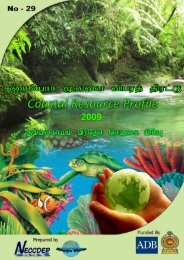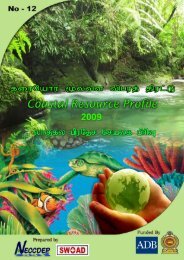Untitled - Neccdep.com
Untitled - Neccdep.com
Untitled - Neccdep.com
Create successful ePaper yourself
Turn your PDF publications into a flip-book with our unique Google optimized e-Paper software.
TRINCOMALEE BAY SPECIAL MANAGEMENT AREA Page | 38<br />
164. Crab fattening is also an important mariculture (aquaculture) practice in Kinniya which<br />
has developed relatively recently. It is carried out in lagoons, in cages, which are fully<br />
submerged resting on the bottom at 4-5 ft depth. Typically, wild caught mud crabs (Scylla<br />
serrata), which have just molted, are held in the cages for about one month, and fed heavily<br />
on raw fish (fish offal, sardines, and skate). The muscle tissue inside the shell increases<br />
rapidly in mass and fills out the new shell. The crabs are then sold to buyers who transport<br />
them to Colombo for export.<br />
165. A private <strong>com</strong>pany has started a fish culture (sea bass) project in Thampalagamam<br />
bay recently and there has been a mixed response from fishers recorded in the field studies.<br />
The profit margin of the sea bass culture is not attractive for fishers when <strong>com</strong>pare to the<br />
cost of labour and the cost of the cage. On the other hand, the buying price is decided by the<br />
<strong>com</strong>pany which is lower than the market price in Kinniya. The fishermen cannot develop their<br />
own cage culture because they don’t have a mechanism to get the fingerlings. Discussion<br />
with NAQDA revealed that it is planning to develop hatcheries but this will take another 2-3<br />
years. Hence there is limited potential for fish culture due to market issues.<br />
166. Thampalagamam bay used to be important for windowpane oysters (Placuna<br />
placenta), and in the 1950s a total of more than 4 million oysters were harvested. However,<br />
the industry was totally destroyed in 1957-1958 due to heavy floods, possibly exacerbated by<br />
overexploitation. Pearl oyster (Pinctada margaritifera), green mussel (Perna viridis), and<br />
horse mussel are <strong>com</strong>monly found in Clappenburg point and Inner Harbour area. Efforts are<br />
necessary to revive the oyster industry, and studies are being carried out on raft culture for<br />
mussels.<br />
d. Tourism sector<br />
167. Tourism is an important economic activity and has a long history in Trin<strong>com</strong>alee.<br />
Organized tourism started almost 30 years back with the establishment of tourist hotels and<br />
group tours by Colombo based tourism <strong>com</strong>panies. The historical Koneswaran temple, hot<br />
water wells in Kanniya and ancient Buddhist temples are well known tourist destinations.<br />
Nilaveli beach is an attraction for foreign and domestic tourists. Puramalai (Pigeon) Island is<br />
declared as a National Park by DWLC and is also an important asset for tourism.<br />
Opportunities for whale and dolphin watching also exist and have potential for tourism (Ref.<br />
0950) .<br />
168. Trin<strong>com</strong>alee has long been called the Whale Watching Centre of Sri Lanka and in the<br />
1980s a whale watching industry started to emerge, but was cut short by the conflict<br />
situation. The Indian Ocean is an International Whaling Commission (IWC) Sanctuary and it<br />
is thought that the populations of whale species are increasing. 26 species of the worlds 83<br />
species of Whales, Dolphin and Porpoise have been recorded in Sri Lankan waters including<br />
the iconic Blue, Humpback and Sperm Whales. Although the waters around Trin<strong>com</strong>alee<br />
have been disturbed by security operations, fishermen still report numbers of whales and<br />
dolphins close to the land. Cessation of military activities is likely to increase further the<br />
numbers seen. Whale and dolphin watching from Trin<strong>com</strong>alee can be undertaken both from<br />
land based viewpoints and boats, making it available to a wide range of visitors at an<br />
attractive cost.<br />
169. In 2005, the Ministry of Tourism announced a project to develop Trin<strong>com</strong>alee as a<br />
‘Whale Capital”. The Project, as proposed, included an integrated oceanography centre using<br />
Public Private Investment (PPI) and development of land held by the Sri Lanka Tourism<br />
Development Authority (SLTDA) for tourism / leisure activities at Deadman’s Cove, Sweat<br />
Bay, and Marble Bay. The Project still needs to be implemented.


